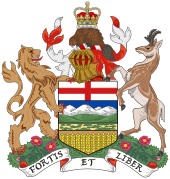Government of Alberta
| Provincial government | |
 | |
| Formation | 1 September 1905 |
|---|---|
| Founding document | Constitution Act, 1867 Alberta Act, 1905 |
| Province | |
| Country | |
| Website | alberta |
| Crown | |
| Sovereign | Monarch (Queen) |
| Vice-regal representative | Lieutenant Governor |
| Legislative (Crown-in-Parliament) | |
| Legislature | Alberta Legislature |
| Meeting place | Legislature Building |
| Executive (Crown-in-Council) | |
| Head of government | Premier |
| Main body | Cabinet |
| Appointer | Lieutenant Governor |
| Headquarters | Edmonton |
| Main organ | Executive Council |
| Judicial (Crown-on-the-Bench) | |
| Court | Court of Appeal |
| Seat | Law Courts, Edmonton |
The Government of Alberta (French: Gouvernement de l'Alberta) refers to the provincial government of the province of Alberta. Its powers and structure are set out in the Constitution Act, 1867.
In modern Canadian use, the term "government" referred broadly to the cabinet of the day (formally the Executive Council of Alberta), elected from the Legislative Assembly of Alberta and the non-political staff within each provincial department or agency – that is, the civil service.
The Province of Alberta is governed by a unicameral legislature, the Legislative Assembly of Alberta, which operates in the Westminster system of government. The political party that wins the largest number of seats in the legislature normally forms the government, and the party's leader becomes premier of the province, i.e., the head of the government.
Lieutenant-Governor of Alberta[]
The functions of the Sovereign, Elizabeth II, Queen of Canada, and known in this province (Alberta) as the Queen in Right of Alberta, are exercised by the Lieutenant Governor of Alberta. The Lieutenant Governor is appointed by the Governor General of Canada on the recommendation of the Prime Minister of Canada, in consultation with the Premier of Alberta.
Executive powers[]
Typically, although not necessarily, consisting of members of the Legislative Assembly, the Cabinet of Alberta is similar in structure and role to the Cabinet of Canada. As federal and provincial responsibilities differ there are a number of different portfolios between the federal and provincial governments.
The lieutenant governor, as representative of the Queen, heads the council, and is referred to as the Governor-in-Council. Other members of the Cabinet, who advise, or minister, the vice-regal, are selected by the premier and appointed by the lieutenant governor. Most cabinet ministers are the head of a ministry, but this is not always the case. In the construct of constitutional monarchy and responsible government, the ministerial advice tendered is typically binding, although the royal prerogative belongs to the Crown, not to any of the ministers.[1]
Legislative powers[]
The Legislative Assembly of Alberta is the deliberative assembly of the Alberta Legislature for the province of Alberta, Canada, and is seated at the Alberta Legislature Building in the provincial capital of Edmonton. The Legislative Assembly is a unicameral assembly of 87 members, elected first past the post from single-member electoral districts.[2] Bills passed by the legislature are given Royal Assent by Elizabeth II, Queen of Canada, represented by the Lieutenant-Governor of Alberta.[3] The current Legislature is the 30th, since Alberta entered Confederation under the Alberta Act in 1905, and is composed of members elected in the April 16, 2019 general election, and returned a majority parliament controlled by the United Conservative Party commonly abbreviated to 'UCP'.
See also[]
References[]
- ^ Neitsch, Alfred Thomas (2008). "A Tradition of Vigilance: The Role of Lieutenant Governor in Alberta" (PDF). Canadian Parliamentary Review. Ottawa: Commonwealth Parliamentary Association. 30 (4): 23. Archived from the original (PDF) on July 14, 2012. Retrieved May 22, 2009.
- ^ "Legislative Assembly of Alberta". www.assembly.ab.ca.
- ^ The Alberta Act, 4-5 Edw. VII [1905], c. 3 (Canada), s. 12 .
External links[]
- Government of Alberta